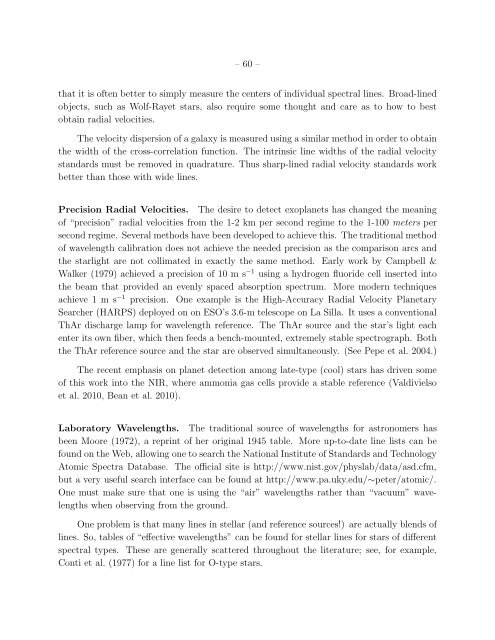Astronomical Spectroscopy - Physics - University of Cincinnati
Astronomical Spectroscopy - Physics - University of Cincinnati
Astronomical Spectroscopy - Physics - University of Cincinnati
You also want an ePaper? Increase the reach of your titles
YUMPU automatically turns print PDFs into web optimized ePapers that Google loves.
– 60 –<br />
that it is <strong>of</strong>ten better to simply measure the centers <strong>of</strong> individual spectral lines. Broad-lined<br />
objects, such as Wolf-Rayet stars, also require some thought and care as to how to best<br />
obtain radial velocities.<br />
The velocity dispersion <strong>of</strong> a galaxy is measured using a similar method in order to obtain<br />
the width <strong>of</strong> the cross-correlation function. The intrinsic line widths <strong>of</strong> the radial velocity<br />
standards must be removed in quadrature. Thus sharp-lined radial velocity standards work<br />
better than those with wide lines.<br />
Precision Radial Velocities. The desire to detect exoplanets has changed the meaning<br />
<strong>of</strong> “precision” radial velocities from the 1-2 km per second regime to the 1-100 meters per<br />
second regime. Several methods have been developed to achieve this. The traditional method<br />
<strong>of</strong> wavelength calibration does not achieve the needed precision as the comparison arcs and<br />
the starlight are not collimated in exactly the same method. Early work by Campbell &<br />
Walker (1979) achieved a precision <strong>of</strong> 10 m s −1 using a hydrogen fluoride cell inserted into<br />
the beam that provided an evenly spaced absorption spectrum. More modern techniques<br />
achieve 1 m s −1 precision. One example is the High-Accuracy Radial Velocity Planetary<br />
Searcher (HARPS) deployed on on ESO’s 3.6-m telescope on La Silla. It uses a conventional<br />
ThAr discharge lamp for wavelength reference. The ThAr source and the star’s light each<br />
enter its own fiber, which then feeds a bench-mounted, extremely stable spectrograph. Both<br />
the ThAr reference source and the star are observed simultaneously. (See Pepe et al. 2004.)<br />
The recent emphasis on planet detection among late-type (cool) stars has driven some<br />
<strong>of</strong> this work into the NIR, where ammonia gas cells provide a stable reference (Valdivielso<br />
et al. 2010, Bean et al. 2010).<br />
Laboratory Wavelengths. The traditional source <strong>of</strong> wavelengths for astronomers has<br />
been Moore (1972), a reprint <strong>of</strong> her original 1945 table. More up-to-date line lists can be<br />
found on the Web, allowing one to search the National Institute <strong>of</strong> Standards and Technology<br />
Atomic Spectra Database. The <strong>of</strong>ficial site is http://www.nist.gov/physlab/data/asd.cfm,<br />
but a very useful search interface can be found at http://www.pa.uky.edu/∼peter/atomic/.<br />
One must make sure that one is using the “air” wavelengths rather than “vacuum” wavelengths<br />
when observing from the ground.<br />
One problem is that many lines in stellar (and reference sources!) are actually blends <strong>of</strong><br />
lines. So, tables <strong>of</strong> “effective wavelengths” can be found for stellar lines for stars <strong>of</strong> different<br />
spectral types. These are generally scattered throughout the literature; see, for example,<br />
Conti et al. (1977) for a line list for O-type stars.

















